Archive for the ‘art and activism’ Category
The Problem With Trump
Is that he doesn’t give a shit. He doesn’t care what you think. He doesn’t care what the law says. He doesn’t care about the history of the United States. Trump could give a flying shit about the constitution as well as the Haitians.
The problem with Trump is that he constructs his own reality at intervals. He could give a shit about reality, because he’s never had to live in reality. This is a golden spoon child, given $10 Million dollars to kick off an NYC real estate developer’s career without any clue of how the overwhelming vast majority of people live.
The problem with Trump is that WE ARE ALL SHIT HOLES.
The problem with Trump is that he has gotten the highest public service office in the United States of America without any experience or care for public service. He could give a flying fuck about public service, after all it’s work for shit holes to serve shit holes.
The problem with Trump is that he’s never had to work, he’s never had to earn a living, he’s never had to struggle.
The problem with Trump is that he has no political career to ruin as a shitty president, so he can give a flying fuck whether or not he shits on everything that this country has been built upon such as immigrants.
The problem with Trump is that he made his career as a real estate developer. He made his career as a TV producer and reality TV personality and an ego-maniac.
The problem with Trump is that he could give a flying shit about anyone other than himself and his own. He doesn’t understand public service or governance or the middle class or women or poverty or history or struggle or global citizenry or activism or ethics or morality.
And to all the white supremacist, America First, racist fucks who voted for Trump, if you are not a millionaire, you are a SHIT HOLE and he’s going to make you pay.
Realidad VE
Realidad VE is a small experiment that attempts to combine documentary material with virtual space for VR presentation.
Last fall I had an extended interview with José Bergher a retired professor and classically trained musician from Venezuela who was the director of the Symphony Orchestra of Venezuela. Throughout his professional career he worked between New York City and Caracas and the reason behind the interview was to learn about that dual citizenry – about living between cultures and floating from one part of the world to the other. However as the interview progressed, I asked José about the current state of Venezuela – politically, economically and the common problems that people face day to day. He replied with a 20 minute discussion of the rise of Chavez and the current power-grab by Maduro and the lasting influence of Fidel Castro.
I knew that this discussion would not be appropriate for the project that I was working on, but I appreciate his first-hand perspective and given the last several weeks in Venezuela, I wanted to present his voice in a unique format. Entirely based on my news consumption of current protests, clashes and seemingly general instability in Venezuela, I created a blank world with the exception of dead trees and abandoned drilling rigs. The world is populated by men and women running across the space. A boy sits against a tree taking in the world around him. At another spot a young couple argues and elsewhere two friends are in discussion. Along the entire perimeter paramilitary troops stand guard and watch the space. At a couple spots trios of soldiers have friendly discussions. In this world, the military is at ease, though watchful whereas the people appear frantic.
I’m interested in combining documentary material such as the interview with José Bergher with virtual space and employing virtual reality as a platform for documentary. Jose’s discussion of current Venezuelan politics presented an opportunity for experimentation. Pictured above is the project for installation that features an animated José Bergher above the virtual space, the project is online with out Bergher’s video, only his voice accompanies the virtual space as the inclusion of video made an already long load time much longer.
“Once Upon a Place” at Time Square
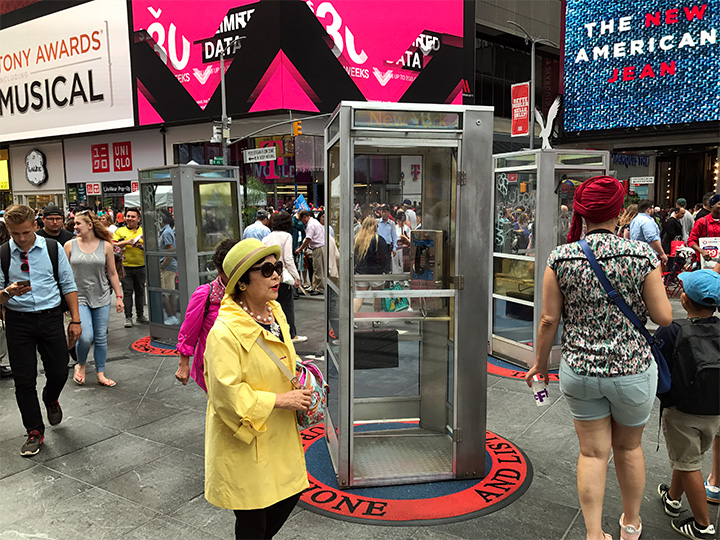
“Once Upon a Place” by Aman Mojadidi at Time Square
Repurposed public phone booths are a poor vehicle for the sharing of immigrant stories. As an artist largely dedicated to reflecting upon migrant populations and cultural dislocation, as soon as I heard about Aman Mojadidi’s “Once Upon a Place”, installed at Time Square, I knew that I needed to visit the project. I worked out a deal with my son and hauled him up to Time Square. Upon entering Duffy Square, we encountered three old phone booths sitting on red and blue carpets with phrases such as “Global Stories” along the circular perimeter.
The first one I entered did not appear to function. I picked up the receiver, put it to my ear and heard only silence. I searched for instructions on the phone as I pushed the numerical keypad, nothing. I pulled out the phone book hanging below a steel shelf, but there was no information as to how to activate the phone. I considered putting coins in the slot, but didn’t have any. So then I stepped out, and read the signage for the project, still no instructions. At this point, the other phones were empty so I tried a second phone booth.
Upon putting the receiver to my ear, I heard the voice of a woman. She was from Mexico and she was describing the hardships and poverty of her home town. The story was brief. She was followed by a man from West Africa, I do not recall the country. He has well explained his desire for a new life due to the intense poverty of his upbringing. The next man, if I recall correctly was Dominican and he explained how his entire family had immigrated to the United States. He was left alone in his country, so he felt that he had little choice but to migrate to the United States…
I believe that the reason that I don’t recall details from these personal stories, besides the fact that it was hot and uncomfortable in the phone booth, is that they were not very interesting. The use of the repurposed phone booth to share immigrant tales is clever (though I don’t recall and can’t imagine a phone booth ever being a popular means to call family across borders), but the framing and presentation of the content does not make the work compelling. Ultimately, the work relies on the strength of the subjects the artist has captured and the artist’s capability to steer the conversation or interview and stir nuance from the subject. The three subjects (of 70) that I listened to were not engaging story tellers. Their experiences were sad and clearly state the need to escape a harsh reality and yet they did not summon empathy or any emotional reaction in me.
However, my time with the project was cut short, by a bored nine year old, who started tapping down the phone’s hookswitch and with each tap the voice from the receiver would go silent. The recording would not pause as when he lifted the hookswitch and I heard the voice again, it did not begin from the stopping point, but rather the audio was continual. So once we were both frustrated, I relented to his desire to move on.
We sat in the stands over looking Duffy Square and ate lunch. I continued to observe the installation. Sadly there was very little interest in the project from the throngs of tourists on a summer Saturday afternoon as the phone booths remained largely empty. Occasionally a curious tourist would poke her head in, listen for a few seconds and then walk out.
My take away from interacting with the installation and observing the public interest: a multitude of stories or interviews, apparently a total of 70, does not generate an interesting project. A single compelling story teller is more significant than many interviewees. Secondly, I found the combination of the immediate surroundings and the heat within the phone booth too distracting to focus on the audio for very long. Time Square is not a good location for audio installations that rely upon focused engagement. Lastly, I’ve got to stop taking my son to see art work that I wish to engage with for any extended period of time. Perhaps, I’ll go back at night by myself and have a different experience.
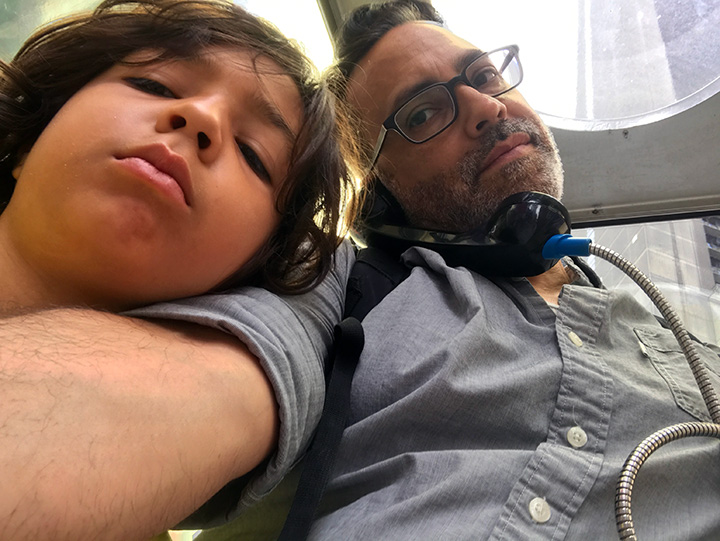
Sharing the phone at Aman Mojadidi’s “Once Upon A Place”
The installation commissioned by Time Square Arts will continue to be available until September 5th at Duffy Square – West 46th Street and Seventh Avenue.
“Hansel & Gretel” at Park Avenue Armory – Save Your Money

The “Hansel & Gretel” curatorial statement describes the installation as a space that brings together Jacques Herzog, Pierre de Meuron and Ai Weiwei combined interests in
the psychological impact of architecture and the politics of public space; creating a playful, strange, and eventually eerie environment with different layers of reality revealed to the visitor… Hansel & Gretel is a dystopian forest of projected light where the floor rises up, as if lifted by an invisible force, and visitors are tracked by infrared cameras and surveyed by overhead drones as they systematically capture the parkgoers’ data and movements…
Unfortunately, the only portion of this description that resonates is the playfulness. Indeed Herzog, de Meuron and Weiwei have created a dark environment in which visitors may skip around and play with light traces of their image. However, the installation lacks strangeness, eeriness, politics or any psychological reverberation.
Other than the initial moment of discovery that one’s image is being projected on to the ground after it is periodically taken due to on one’s movement in the space, the installation presents very little that is interesting. The drones may have been a neat prop had they not been tethered.
The second part of the installation is a didactic revelation of what the installation is trying to allude to – that we are objects of surveillance. As far as a critical art installation regarding surveillance, there was much more interesting work done 15+ years ago. Perhaps the theme of surveillance has been so overly investigated and picked apart by art previously and by entertainment today (“Black Mirror” for example) that such an installation seems trite and naive. There is so much of our data being captured today, that building an installation that merely plays upon facial recognition and motion sensors is just kind of dumb, but it is playful. So if $16 is worth the cost of running around a huge dark open space and playing with light projection, check it out.
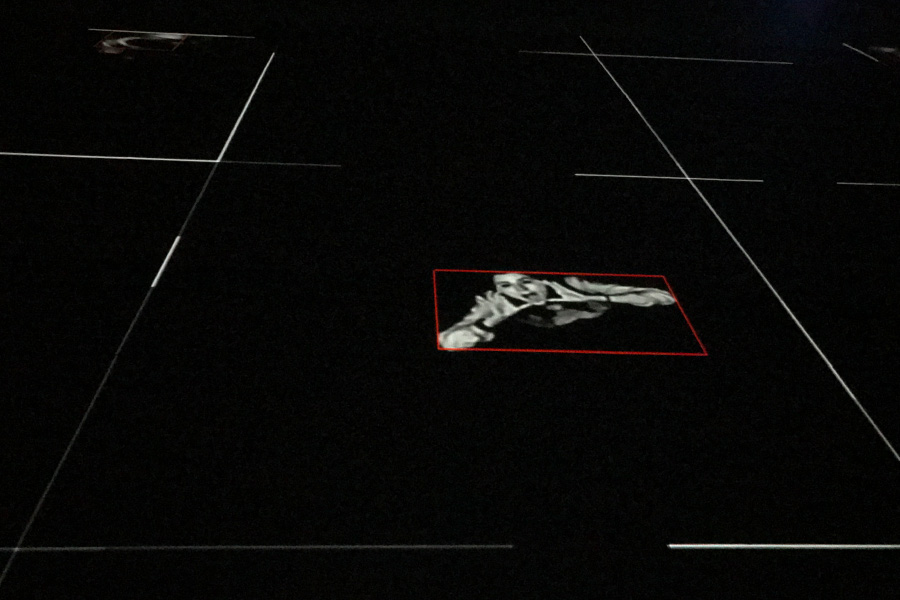
A second perspective: Playtime at the Armory
Once again discovering what this city has to offer, there I was with Ricardo walking into a venue called the Armory near Hunter College, a place I had never been before to see a new art installation called “Hansel & Gretel”. He had been keen to check this out for a few weeks, and like the curious creature I am, I followed along.
We received a quick intro and were instructed to read a phase on the wall before entering -which i forgot- and then allowed to enter. We walked into black nothingness. My immediate reaction was to scramble for Ricardo’s hand. I didn’t realize the massiveness of this place until my eyes adjusted from the summer sunlight to the darkness inside of the Armory. It was only eerie the first few minutes because I had no idea where the hell I was walking. There were a few cameras far above us hanging from the ceiling and lights that would follow us. As we continued to walk, our movement was detected, grid lines would appear and cameras would be activated to capture our moves. Suddenly, it was playtime! It was fun to pose in different positions to watch the resulting snap shot of yourself illuminated on the black floor. At one point my sweater and shoes came off and I really got into it.
Ricardo noticed two drones hovering on one side of the space living poor unfulfilled lives- tied onto leashes without free movement. It would have been more interesting if they were chasing people around. After exhausting our ideas for poses, the novelty wore off and we were ready to enter part deux of the installation. For that, we had to exit this part of the Armory and enter from another entrance on the other side of the street.
After pausing in front of a camera you were allowed inside. There were many ipads on long tables with apps. You could elect to have your face identified and then search the cameras for your photo which was taken in the first part of the installation. That was cool. You could read about the history of surveillance, or access cameras to spy on others walking into the exhibits. The Armory itself was impressive, the installation not as much. It was a new, interesting experience- a fun activity for kids, I would say. I didn’t leave with the feeling that I had witnessed an impressive statement against today’s constant scrutiny and monitoring that we are all under. I didn’t feel intruded upon. There wasn’t anything menacing or fantastical as is described in the program leaflet. It was just pretty cool and fun.
Perhaps the work behind the installation was complicated, but with my lack of technical know-how, I failed to appreciate the amount of effort involved. To have truly made an impact, more could have been done to confuse or play with the audience with the intention of throwing them off or perhaps even scaring them. Coupling that with the sound of Russian men having conversations in the background (that felt clandestine in nature), and I would have possibly left quite feeling differently.
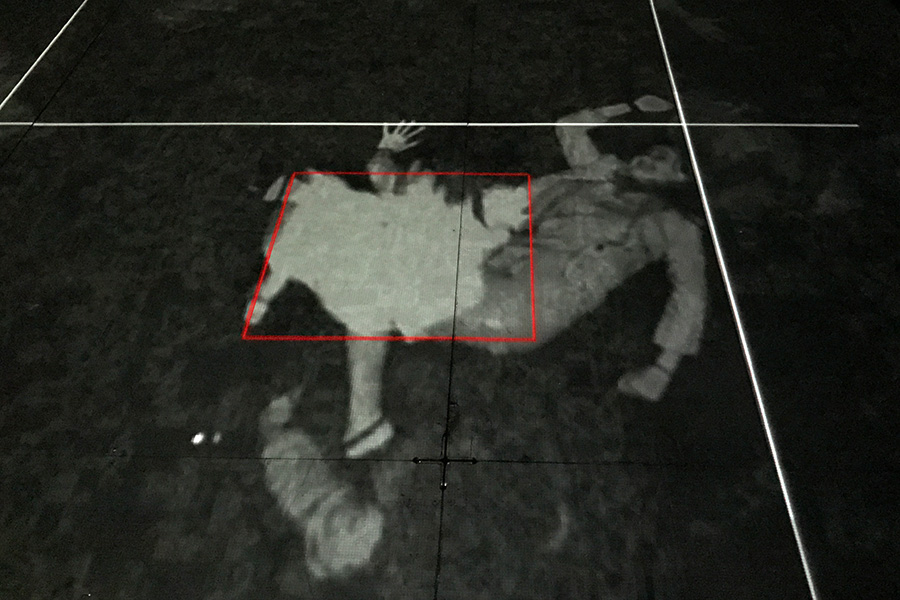
Trump Administration Fantasy League



I don’t play fantasy sports, not because I wouldn’t enjoy it, but more so because I’m not enough of a sports fan. I am however a measured political junky, so when I learned about the Trump Administration Fantasy League, I discovered a fantasy sport that I could find the time and interest to join! Join the Trump Administration Fantasy League by using the site’s random number generator to draft seven unique players from Trump’s administration that includes a selection of 29 players. Then track the league news via Twitter and see your players gain points! The creator of the site Matt McCaleb has been closely monitoring the latest news on the Trump administration to maintain up to date player stats!
Currently former National Security Advisor Mike Flynn is at the top of the score board at 100 points. Devin Nunes is a far second at 65 points. Trump needs to up his game as he’s only fourth at 35 points. If he launches a war against North Korea, I’m certain he’d win hands down (although I don’t see launching a war as a possible stat). The stats used to measure the value of the players include:
- Arrested / Arrests another player 100
- Dies / Kills another player 100
- Resigns / Is fired 75
- Flees jurisdiction 75
- Turns state evidence 75
- Prosecuted for a crime / Prosecutes another player for a crime 75
There are many more stats and some that I question the low value of such as “Fabricates information/Reveals another player’s fabrication of information” as only 10 points. The fabrication of information can of course lead to overwhelming consequences, so I feel it should be worth more. Or perhaps in the new world order, information fabrication is far too normalized to be worth much…
It’s tough to select a team, do you go for the most outspoken that may be out of the game sooner than later such as Bannon or the sleazier ones that may play the long game such as Devin Nunes? And why are Eric and Donald Jr Trump one figure?
With the current 29 players, I would select the following seven:
- Steve Bannon
- Kellyanne Conway
- Devin Nunes
- Jared Kushner
- Rex Tillerson
- Vladimir Putin
- and Donald Trump himself
FRANKLIN FURNACE @ 40
Help the Franklin Furnace continue to make the world safe for Avant-Garde Art (the really weird shit that the NEA is afraid of). The Furnace has turned 40 and is now relocated in Pratt Institute, however, in order to re-grant money to artists that challenge the norms of our society, the Furnace needs financial help. Anyone can donate to the Furnace anytime, but at this time the Furnace is holding a benefit art sale and you can participate via Paddle8!
Exhibition, Friday-Saturday April 19-22, 10am-6pm
Reception and Live Auction of Five Works, Saturday April 22, 5-7pm
Metro Pictures, 519 West 24 th Street, New York, NY 10011
FRANKLIN FURNACE @ 40 Honorees
Yoko Ono, Artist
Thea Westreich Wagner & Ethan Wagner, Collectors
Marian Goodman, Gallerist
FRANKLIN FURNACE @ 40 offers for sale original art by:
John Ahearn, Eleanor Antin, Ida Applebroog, Judith Bernstein, Patty Chang, Nicolas Ceccaldi, CRASH, Kate Gilmore, Felix Gonzalez-Torres, Ann Hamilton, David Hammons/Clifford Owens, Mona Hatoum, Jenny Holzer, Joan Jonas, Barbara Kruger, Suzy Lake, Louise Lawler, Maggie Lee, Robert Longo, Ana Mendieta, Franco Mondini-Ruiz, Portia Munson, Lorraine O’Grady, Lady Pink, Pope.L, Ed Ruscha, Carolee Schneemann, Dread Scott, Michael Smith, Anton van Dalen, William Wegman, Lawrence Weiner, Martha Wilson, David Wojnarowicz, Martin Wong.
Fabrica Habana
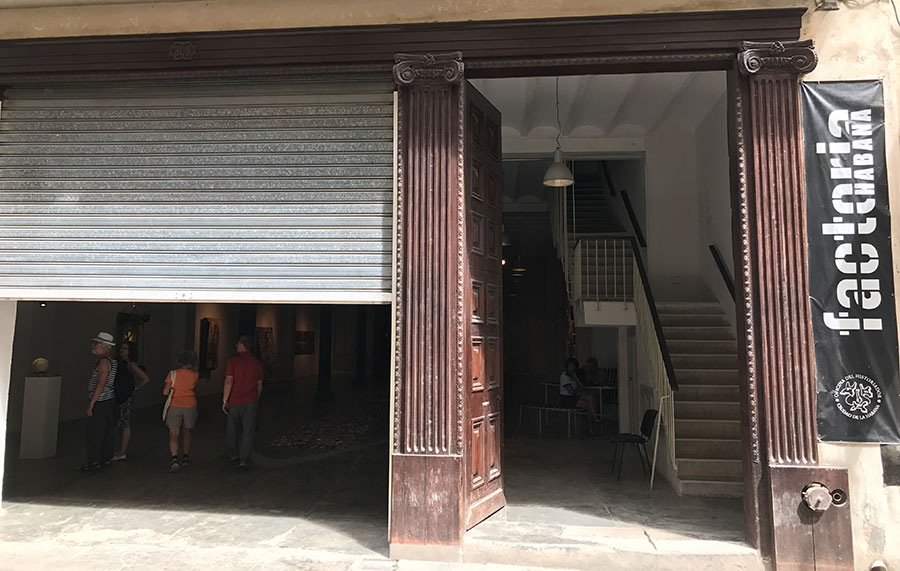
Fabrica Habana, contemporary art gallery of Concha Fontenla, Habana, Cuba
Currently on exhibition at the beautifully renovated colonial home turned contemporary art gallery by Concha Fontenla in Old Habana is a three story exhibition by Cuban artists Jose Toirac and Octavio Cesar Marin. Toirac and Marin draw from various artistic movements such as Conceptual Art and Arte Povera to create a study of the recent history and current reality of Cuba. The gallery consists of three floors and if one begins at the top and works their way down, there is a chronological thread throughout the exhibition. Beginning with allusions to Ancient Western Philosophy and Christianity. On the third floor one will find a broken bronze vase to commemorate Diogenes de Sinope (412-323 BCA), a Greek philosopher of the “escuela cinica” who gave up all material goods and lived as a vagabond on the streets of Athens searching for the honest man.
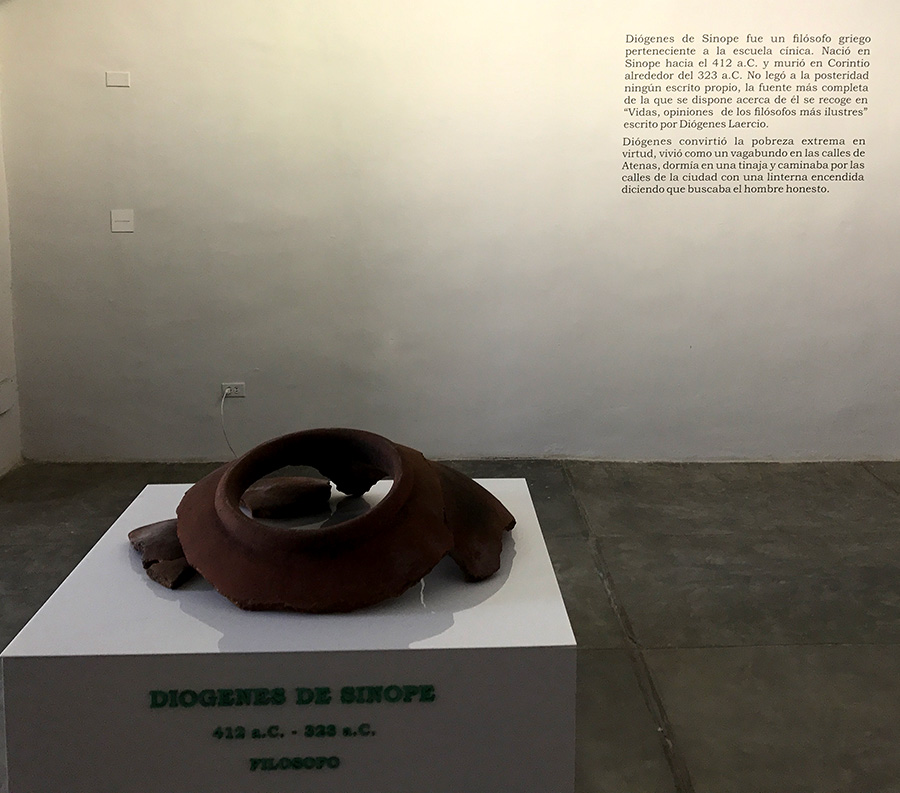
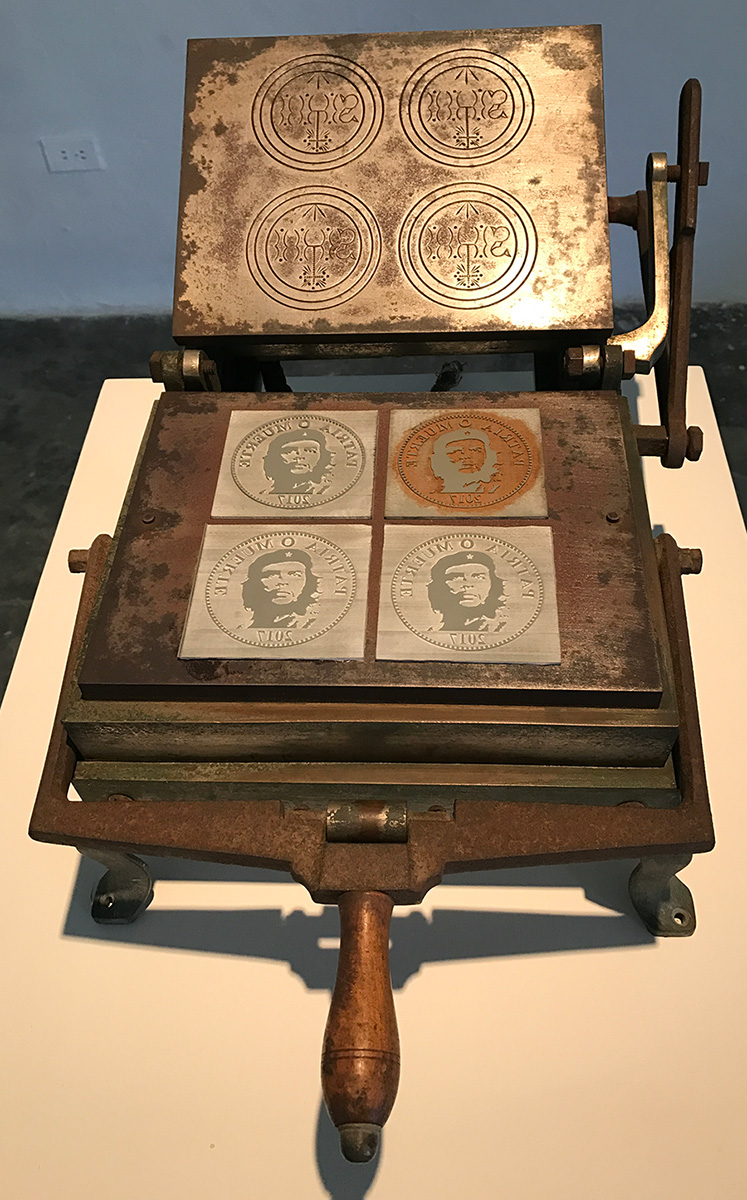
On the same floor, a metal press sits on a pedestal. On one side of the press, is the symbol of christ as stamped on to the eucharist and on the other plate is the portrait of Che Guevara with the phrase “Patria o Muerte 2017”. Above the press is a quote from Fidel, stating that every child should be modeled after Che, an honest and virtuous man. To the right of the press is a long table with two dozen tin cups filled with packaged eucharists stamped with the portrait of the Che. Above the table floats a holy chalice also with the portrait of El Che.
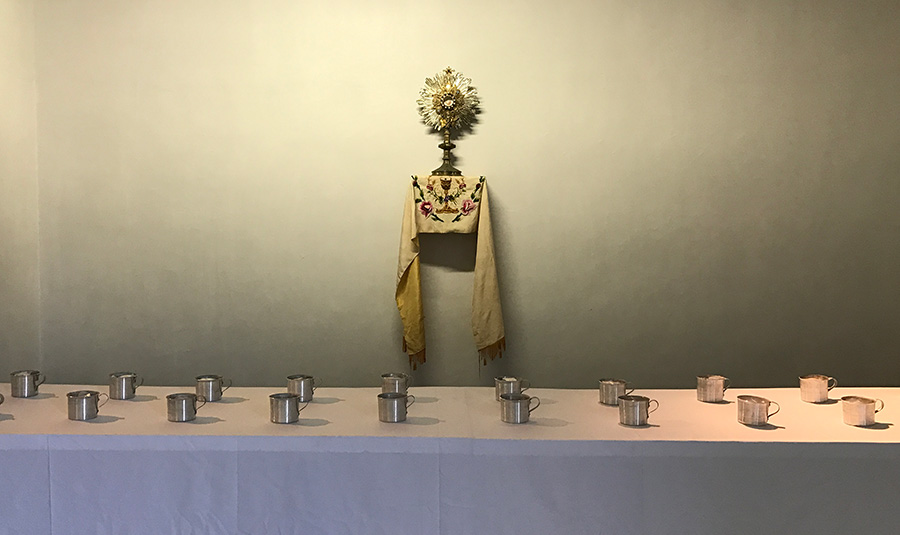
On the second floor one will find many memorials to famous Cubans. Each memorial is a pedestal with the name of the historical figure, the dates of birth and death (if the person has died) and the work that each one is known for and on top of the pedestal are objects commemorating the individual. The memorials include intellectual figures such as Jose Marti as well as business men, a famous cook…
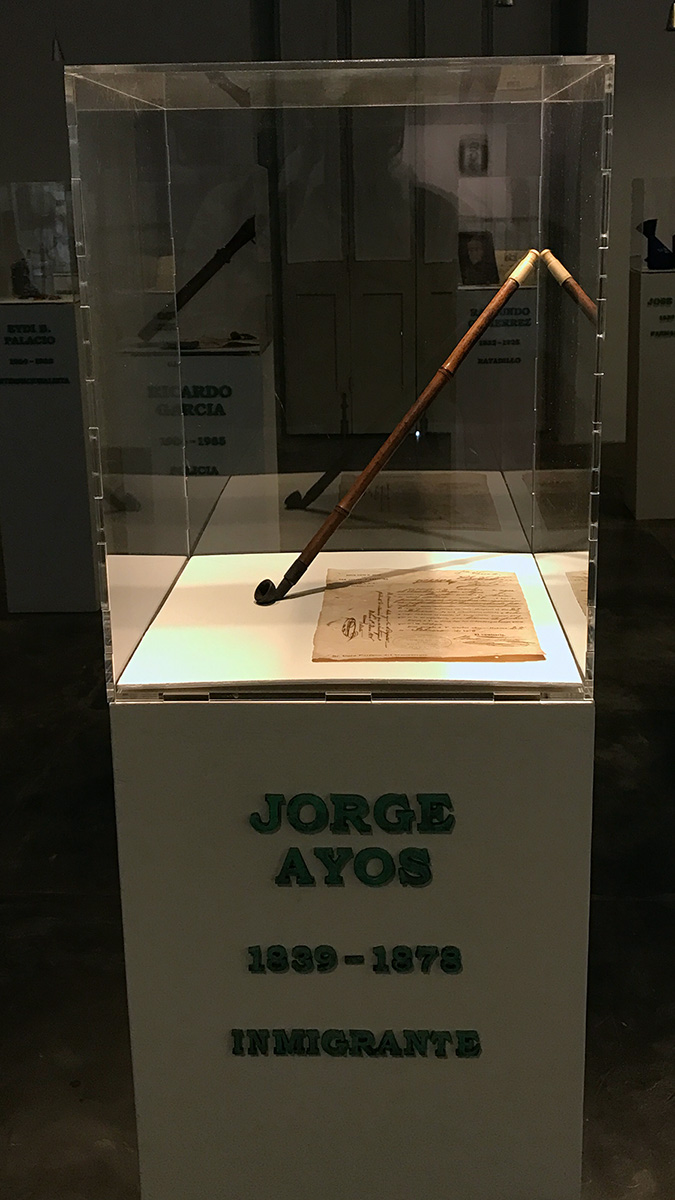
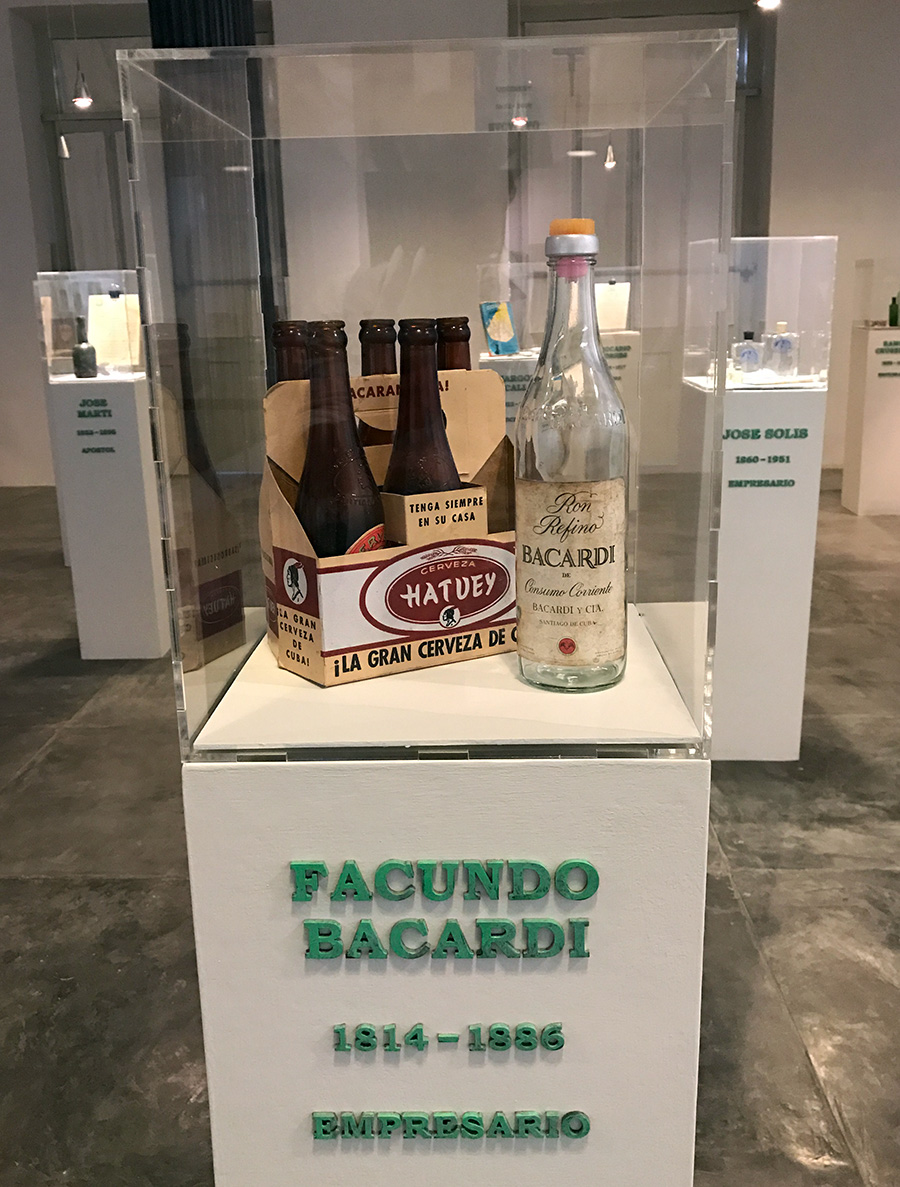
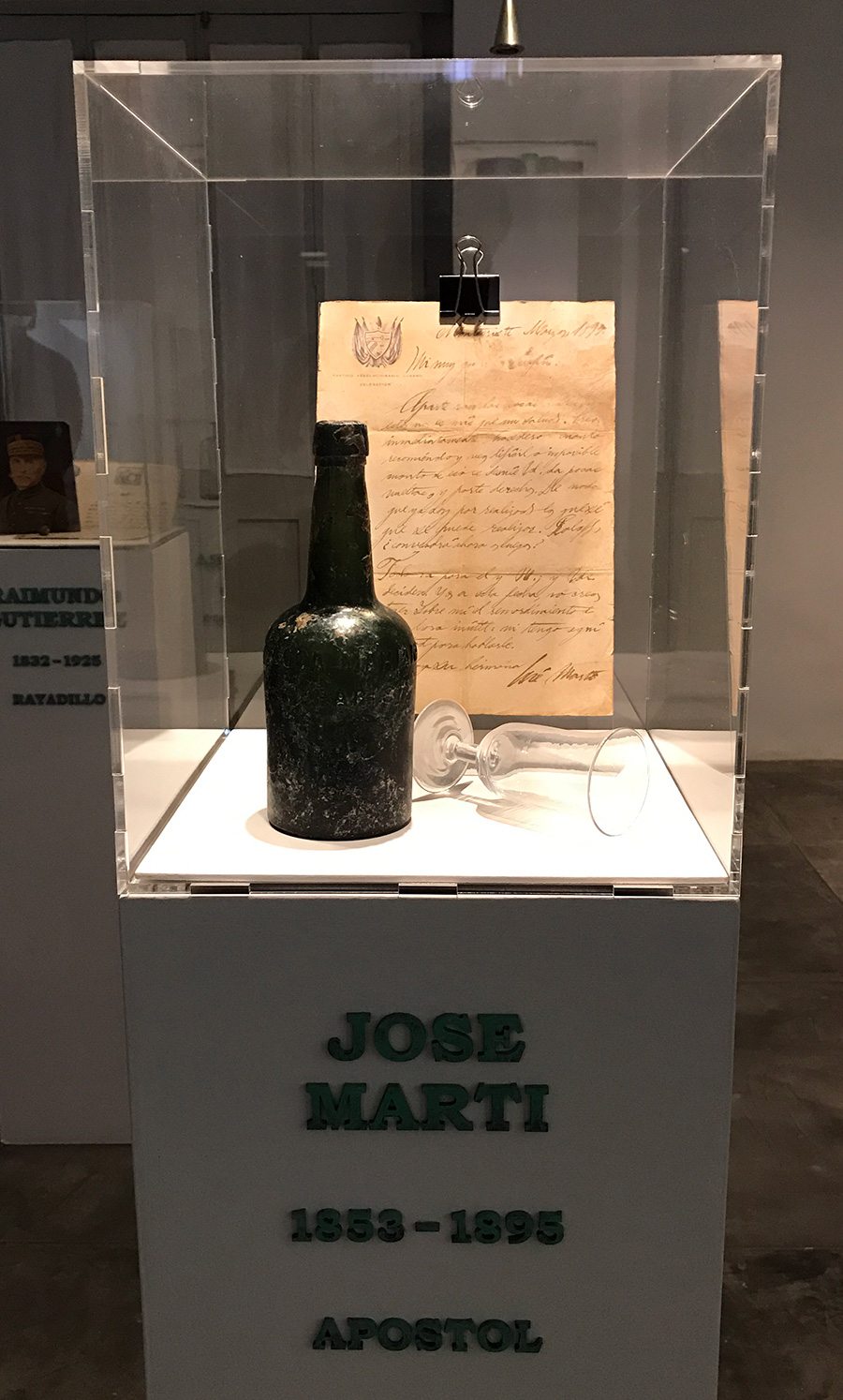
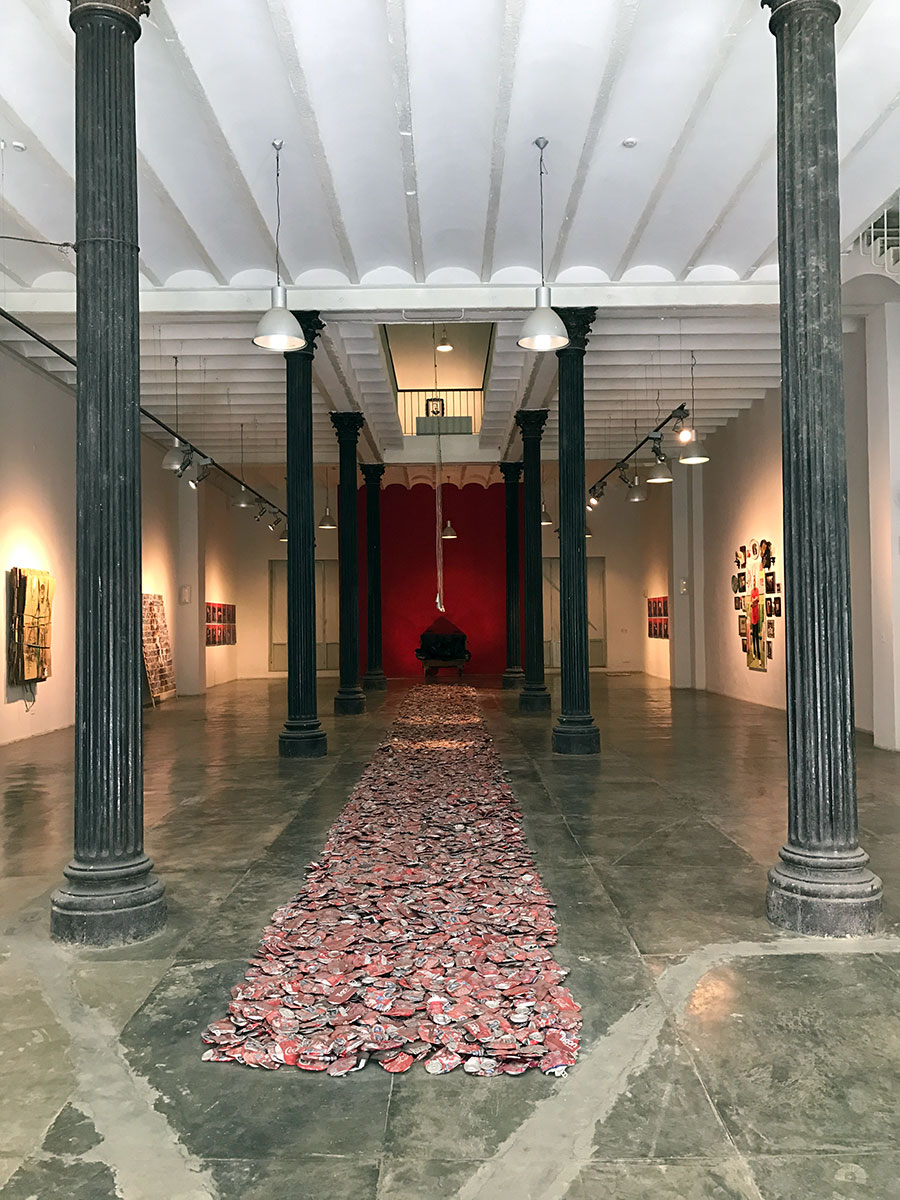 Finally, on the street level, the artists present a red carpet made of flattened tin cans of Cuban beer and soda. And on the three walls of the gallery hang a series of portraits of Cubans today from a street recycler to a flower vendor a famous chef. Each of these portraits are executed on the material or tools of their trade. At the rear of the gallery, are a couple dozen portraits shot on a steel cart with trash bags (that is installed against the rear wall). These portraits seem a bit trite as they try to emulate professional studio portrait images. However the larger portraits are beautifully executed.
Finally, on the street level, the artists present a red carpet made of flattened tin cans of Cuban beer and soda. And on the three walls of the gallery hang a series of portraits of Cubans today from a street recycler to a flower vendor a famous chef. Each of these portraits are executed on the material or tools of their trade. At the rear of the gallery, are a couple dozen portraits shot on a steel cart with trash bags (that is installed against the rear wall). These portraits seem a bit trite as they try to emulate professional studio portrait images. However the larger portraits are beautifully executed.
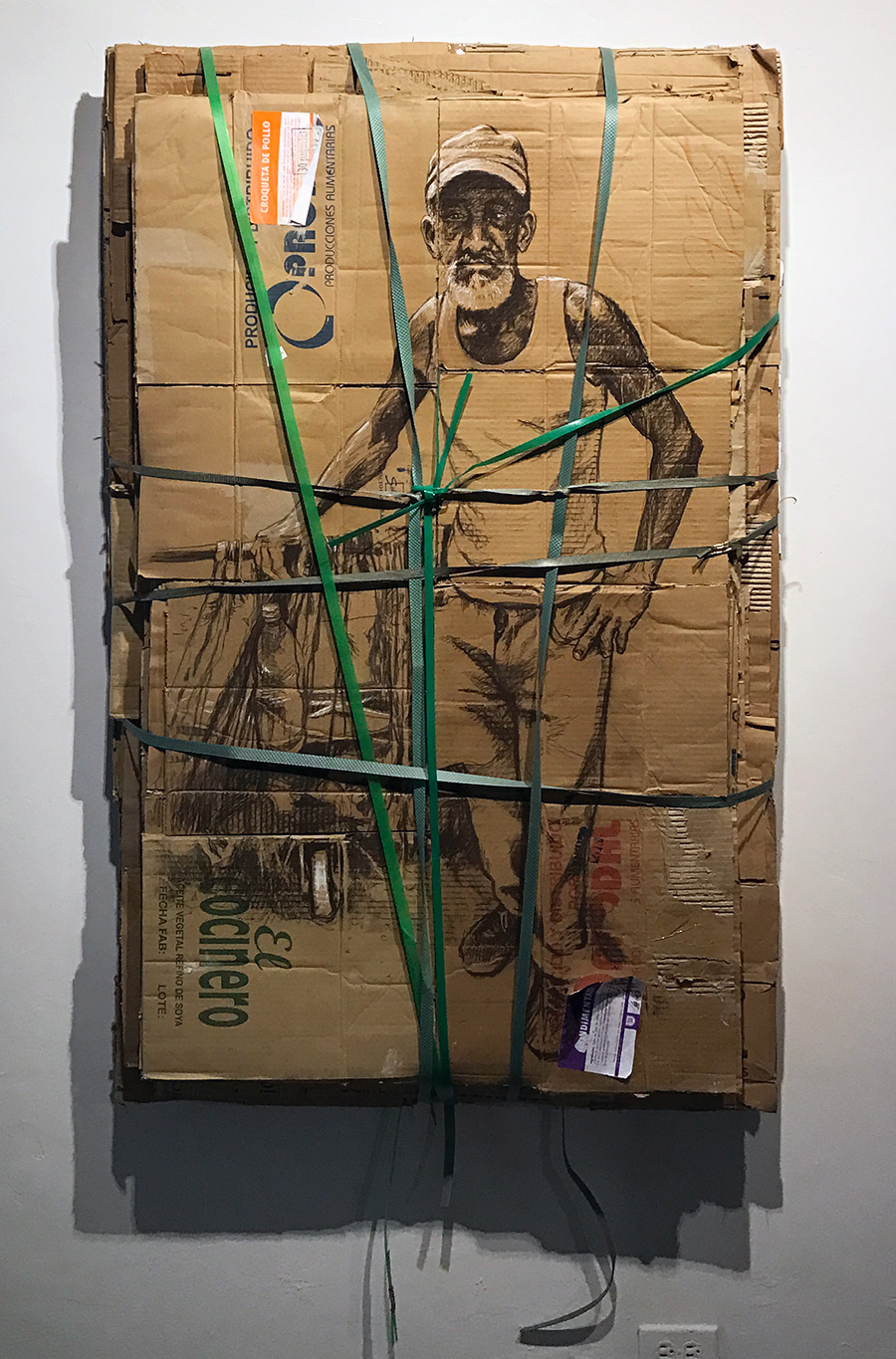
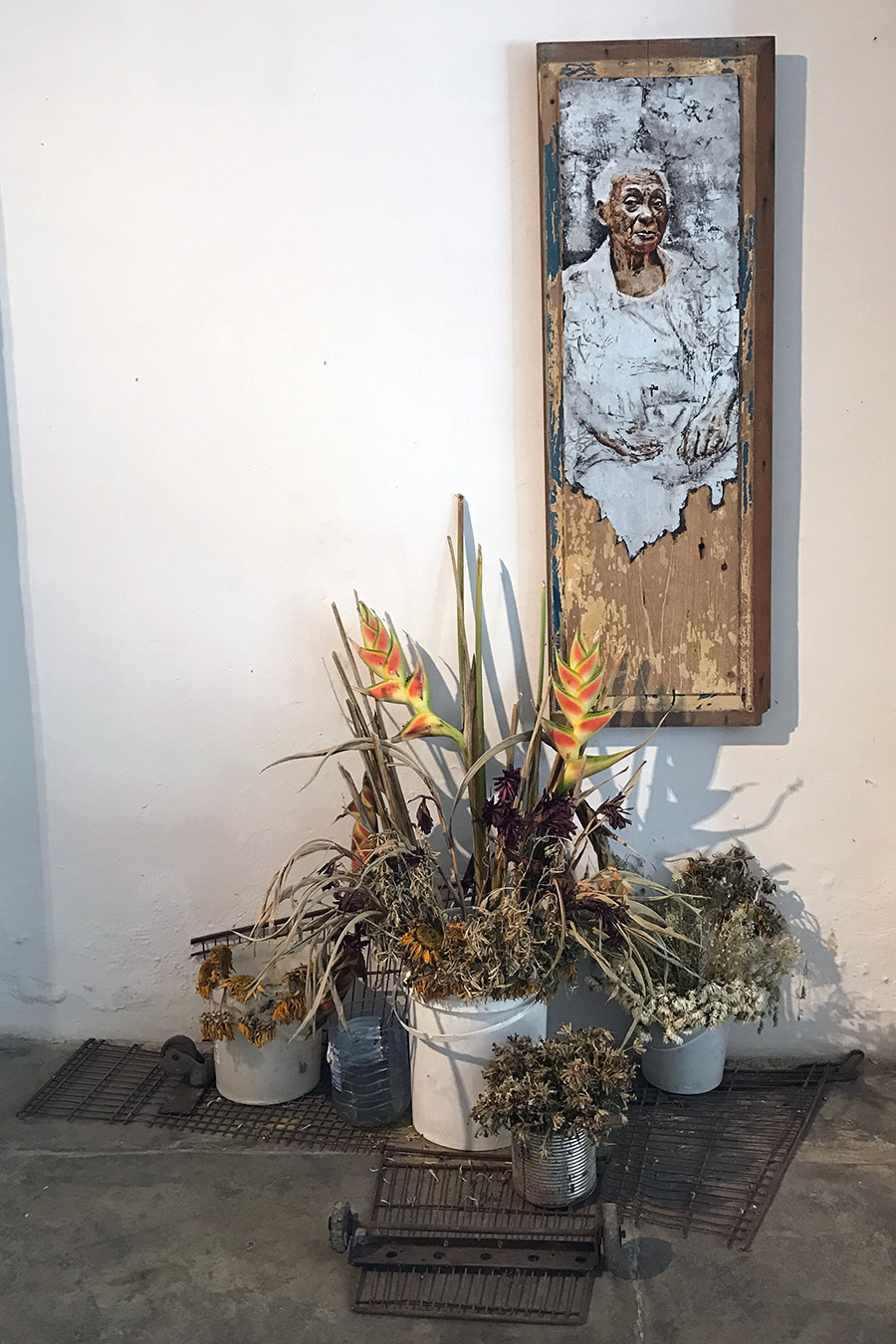
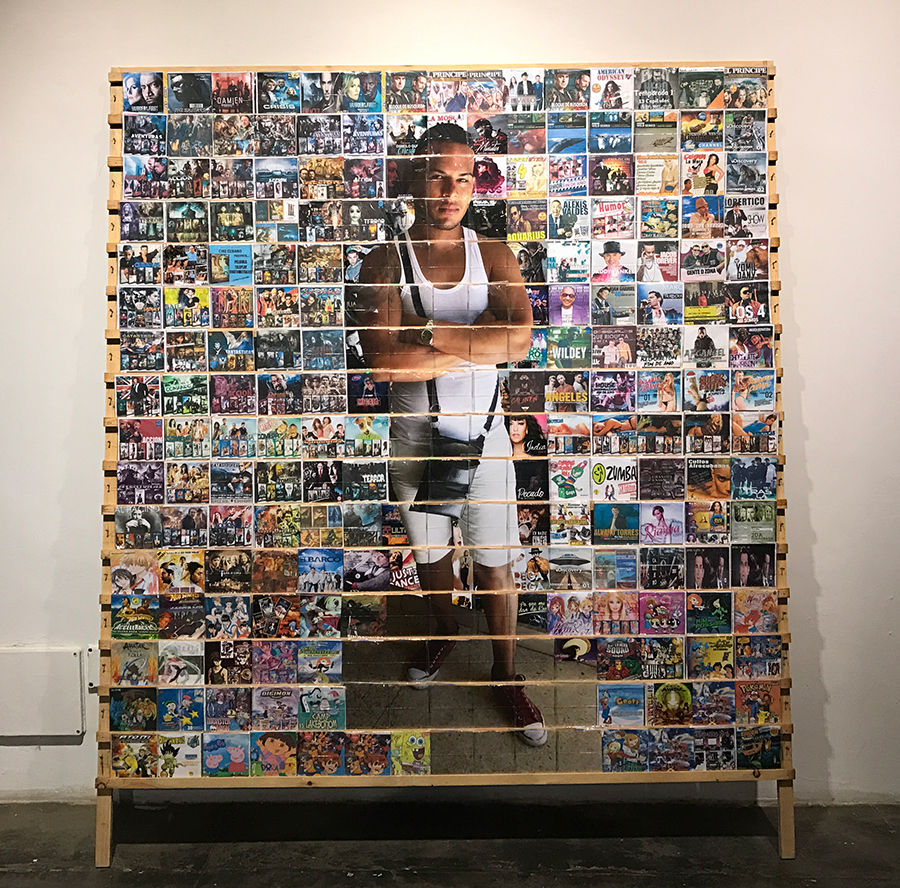
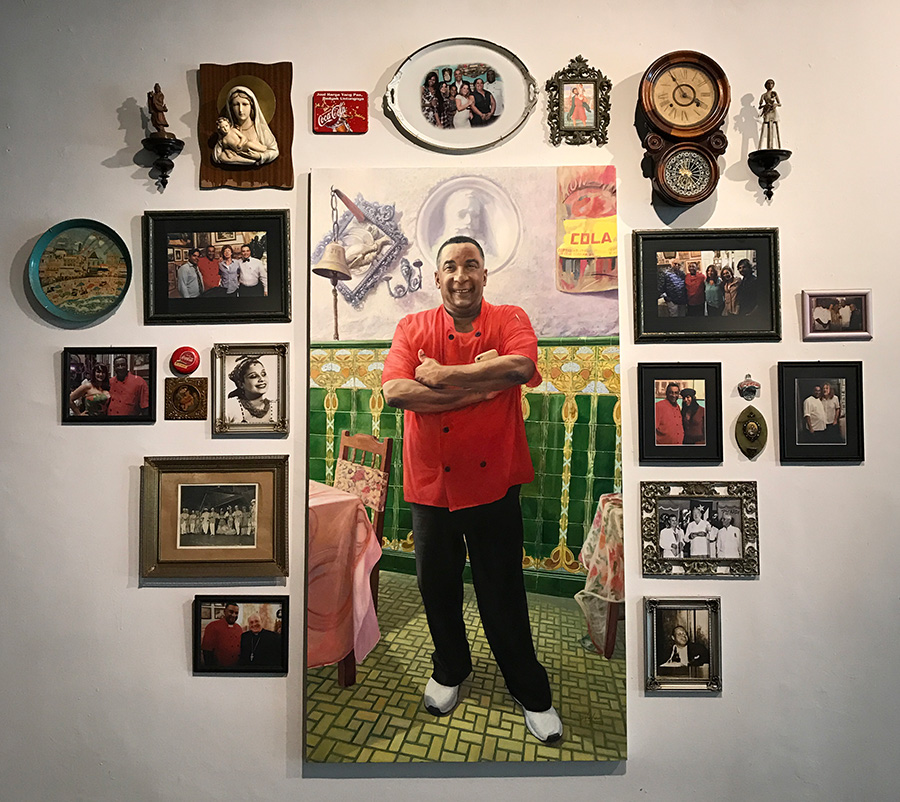
Kelly Sears’s Animations During Trump Administration
Animator Kelly Sears creates eerie speculative narratives by superimposing a voice on to archival footage. The voice presents a state of surveillance and authoritarianism as the viewer watches post-war American footage that she manipulates through various forms of animation. Sears’s work has even greater resonance and seems increasingly foreboding given the Trumpian political climate.
Although “The Rancher” (2012) uses footage of Lyndon B. Johnson, upon listening to the narration, Trump immediately comes to mind.
The Rancher (excerpt) from Kelly Sears on Vimeo.
“Voice on the Line” (2009) stirs to mind the NSA’s wiretapping, but again with Trump’s assault on immigrants and initial legislative actions, the Trump administration and ICE come to mind as I watch excerpts from this film in which a secret police listen to conversations with phone operators. Unknowingly the operators have become complicit in the monitoring and spying of the U.S. population.
Voice on the Line (excerpt) from Kelly Sears on Vimeo.
AdNauseam Because You Are Tracked
Our clicks appear to be worth money not merely to the mad-men of today, but to the digital overloads that increasingly control the internet. Due to Google popularity and value, it has gained a great deal of control over the surface layers of the internet and in doing so has gained control over a portion of human consciousness. Human consciousness that is very valuable… It can be manipulated and monetized. As with all media, the messages that you see and hear are dictated by the ownership. Once it was thought that no one owned the internet or the web, that it was a free and open space for discourse and exchange. This has not been true for sometime; it really was never true, but early on it was at least less monitored and shaped.
The browser add-on AdNauseam is “designed to obfuscate browsing data and protect users from tracking by advertising networks. At the same time, AdNauseam serves as a means of amplifying users’ discontent with advertising networks that disregard privacy and facilitate bulk surveillance agendas.” We should not be tracked unless we have agreed to be tracked and not in small print.
AdNauseam – Clicking Ads So You Don't Have To from mushon on Vimeo.
Recetas y Gangas: Essex Street Market Installation
Recetas y Gangas (Recipes and Deals) is an audio montage of Essex Street Market vendors and shoppers listing goods for sales or sharing personal recipes. The audio montage was recorded and composed to project the market on to the street through an amplified bullhorn. As pedestrians walk past the Essex Street Market, they hear the recorded voices of people working and shopping in the market. Recetas y Gangas was conceived and produced by Ricardo Miranda Zúñiga in 2016 for the exhibition “Lettuce, Artichokes, Red Beets, Mangoes, Broccoli, Honey and Nutmeg: The Essex Street Market as Collaborator” curated by Nicolás Dumit Estévez Raful and presented at Cuchifritos Gallery, located within the Essex Street Market.
Commonly street markets around the world have both an outdoor and indoor space. The perimeters of the market may extend on to the street to invite pedestrians in to the market. Rather than walls, street markets may present large openings and awnings to create an arcade where people are at once outside and inside. The Essex Market in the Lower East Side of New York City does not have a side walk extension beyond sandwich boards and signage outside its brick wall. The Essex Street Market facade does not even present pedestrian level windows for those outside to peer in to the interior. The facade is rather an uninviting brick facade, perhaps a planned institutional barrier that Mayor La Guardia desired as he sought to take cart vendors off the sidewalk in an effort to clean up the streets from obstacles and noise. For the exhibition “Lettuce, Artichokes, Red Beets, Mangoes, Broccoli, Honey and Nutmeg: The Essex Street Market as Collaborator” at Cuchifritos curated by Nicolás Dumit Estévez Raful, I have sought to extend the Essex Street Market on to the sidewalk through sound.
There is a long history of market vendors announcing, singing or chanting their goods to the public. On Essex Street before cart vendors were moved off the street and into the market, they would call out their goods, hoping to attract buyers. I imagine that when the market first opened this practice continued. Today, walk through a traditional Latin American market and you will hear various products sung in to the air. To develop my project, I solicited vendors to vocalize their products and the more performative, the better. Only two vendors played along, one eagerly – Rosella Albanese from Pain d’Avignon and another through a bit of coaxing – Yanivis Rodriguez of Luna Brothers. You may listen to each of their recordings here. When I was trying to talk Yanivis into the recording while she worked the register, a shopper began to tell me about her recipes for preparing yams. It was an older Dominican woman, perhaps in her 60s who after describing her recipe, told me about the many health benefits of yams.
As I was having a difficult time convincing vendors to sing or chant their goods, I decided to request a recipe from them. This turned out effective as I’ve collected several recipes from vendors and customers. The final piece is an audio montage that captures a portrait of the Essex Street Market through the voices of vendors and customers alike all recorded within the market. The audio montage is titled Recetas y Gangas (Recipes and Deals).


